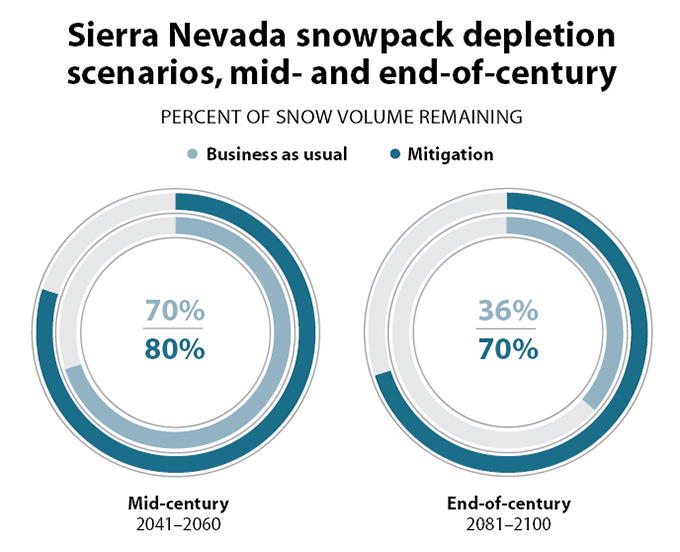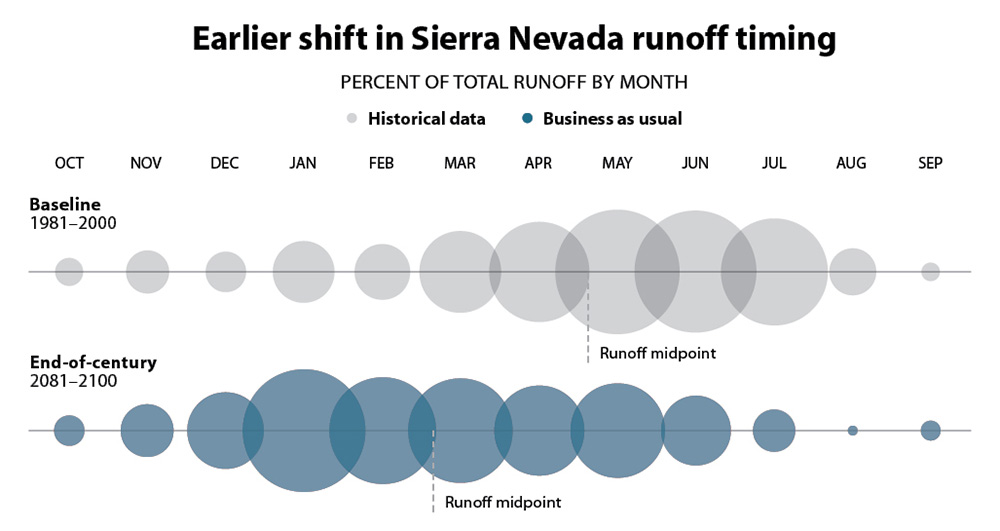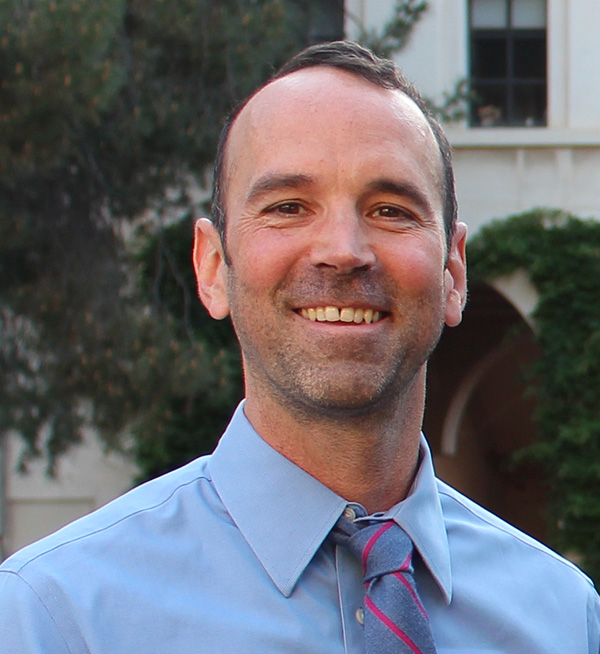
What will happen to the Sierra Nevada’s snowpack as climate change impacts accumulate through the 21st century? This question is vital to both the ecological health of the Range of Light and to water delivery systems throughout California. And, it matters a great deal to Mono Lake and its many miles of tributary streams, which depend on Sierra runoff for their vitality.

Forecasts of the future rely on complex climate modeling, and I talked with Dr. Alex Hall, Professor of Atmospheric & Oceanic Sciences at UCLA, about the work he and his team have been conducting to produce actionable climate science. Dr. Hall heads the Center for Climate Science, where they have developed cutting-edge downscaling techniques to create geographically detailed climate projections for the Los Angeles area and the Sierra Nevada.
Geoff: Thanks for taking time to talk, Alex. You have just released a major report, Climate Change in the Sierra Nevada: California’s Water Future. What are the big takeaway messages?
Alex: Temperatures across the Sierra Nevada are warming. The snowpack is melting earlier, and increasingly, winter precipitation doesn’t arrive as snow in the first place. There’s already a detectable signal in snowpack loss in the Sierra due to anthropogenic climate change—due to human-caused warming. That trend is likely to accelerate in the coming decades so that by the end of the century, if we don’t do anything to reduce carbon emissions globally, we really will see a pretty dramatic loss of snowpack by the end of the snow season. There will only be about a third left compared to the end of the 20th century.
It’s a significant loss and it has all kinds of cascading consequences for water resources, such as changes in runoff timing and more flashiness in stream and river flows, making it harder to capture and store water with current infrastructure. And there are a lot of follow-on impacts to the ecology and wildlife of the Sierra Nevada too.
GM: I was struck by your team’s ability to look back at the recent drought and calculate what part of those years of miserably low snowpack was due to climate change.
AH: There’s a lot of emerging knowledge about detection of climate change signals and attribution of signals to climate change. Part of the reason that the science is becoming so much stronger is because the signals are becoming so much bigger. In the case of the snowpack, 15–25% of the spring snowpack is already missing due to climate change. It’s a big effect. It is important to be able to sharpen up our statements about what role climate change is playing in the signals we are seeing, the extreme events we are seeing, and that’s the work we are trying to advance at UCLA.
GM: So the basic equation here is that climate change brings warmer temperatures, and that causes both less precipitation to fall as snow and also earlier melting of the snow that does arrive, correct?
AH: That is the situation. By the end of the century, if there is no change to emissions, the snowpack shrinks to about a third of what it has historically been. However, if we get our emissions under control, snowpack will be at two thirds of what it was. So there’s a big benefit of global carbon emissions reduction to California, which is that we retain an extra third of our natural water storage in the Sierra. By mid-century, no matter what pathway we are on, snow continues to decline because there is so much climate change baked into the system. That means there is a need for planning, for thought to be given to how to manage water needs and water systems.

GM: Here at Mono Lake we think a lot about what a climate-impacted future means for the level of the lake and the many linked ecological systems. Your report is interesting because the forecast is for about the same amount of total precipitation, meaning rain and snow combined, in the future.
AH: It turns out that the real story in terms of overall precipitation is not the change in the mean, because it does seem that the best answer we have is that there will be very little change to mean precipitation. But California is a land of extreme variability, and the stable average forecast shouldn’t be allowed to hide the much more complicated story, which is about really big increases in extremes.
In a separate paper we found that there will be large increases in the number of wet years, like the 2016–17 wet year, and we found a very significant return period for that type of year. Likewise, drought years return more quickly, especially the further south you go in California. So you add those together and the mean doesn’t change much—but if you are dealing with rapid switching between really wet years and really dry ones it exacerbates the challenges for water management around the state. For example, from the perspective of a utility, the Los Angeles Department of Water & Power had to deal with the recent really wet year that far exceeded the capacity of the aqueduct system.
GM: This suggests that our top Mono Basin climate challenge may not be lake level but instead habitats and wildlife affected by increased extremes and variability.
AH: We didn’t study Mono Lake dynamics specifically, but it seems the big thing to look at is the certain change to the character of the flows into the lake. The habitats these flows support will see significant changes. We found that by the end of the century, under the business as usual emission scenario, there’s an advance in runoff timing of about two months. It varies by watershed but the loss in snowpack causes the runoff to occur much earlier and to be a lot flashier.

GM: That’s a huge shift in snowmelt runoff timing and well outside what stream and forest habitats are built on. Earlier and flashier runoff—what does flashier mean?
AH: If you imagine a precipitation event that dumps a lot of rain instead of snow, it produces a runoff event very quickly in the streams of a watershed. For example, in 2016–17 the events that caused the spillway damage at the Oroville Dam were associated with a warm precipitation event, which is the kind of thing we project will become much more common. In contrast, when precipitation falls as snow it is likely to melt off a lot more gradually, making for a regular and predictable pulse of water. That’s what water managers much prefer.
GM: What’s next for your work and your team?
AH: The limitation of this study is that we are looking at the impact of warming on the climate average. I want to get at this question of the change in the variability of the climate—how far apart the extremes will be and how often we will experience them. We believe that is going to turn out to be a very important element of the climate change story in California, and it’s one that we want to tell in the most robust and scientifically credible way we can. We want to apply all this scientific downscaling know-how we have developed to that problem of looking at changes in variability and changes in extremes.
The other project we are working on is to look at the impact of all of our results, including the changes in snowpack and the changes in variability, on fire in California. It’s a collaboration with fire ecologists and fire management experts, and I think that project will be quite useful. It is likely we can identify climate change signals already present with fire.
GM: Your report forecasts notably different futures depending on emissions scenarios, suggesting all is not lost.

Climate Science at UCLA. Photo courtesy of UCLA.
AH: Yes. If the world undertakes an emission reduction program, like in the Paris Agreement, then we see some loss of snow by the end of the century, but there’s still snowpack remaining and the Sierra Nevada is still broadly the place that we know and love. That’s in stark contrast to the business as usual scenario, which has the very large loss of two thirds of the snow. There’s a big benefit to be gained from a global effort to reduce carbon emissions, and California is, in general, a leader on that path. Large scale change often comes from a smattering of places that transform, as California is doing, and move broader change forward.
At the same time, there are a lot of emissions reductions that are up to individual people implementing changes in how they live their lives. The key is in our hands, and we can accomplish a lot even if the federal government is inactive. Luckily in California we have many options: electric vehicles that really advance the transformation of the vehicle fleet, installing solar panels on our homes, broader energy conservation and water efficiencies. They are all pieces of the puzzle and as individuals we can do a great deal to make emissions mitigation truly happen.
This post was also published as an article in the Summer 2018 Mono Lake Newsletter (pages 3, 4 and 18).
